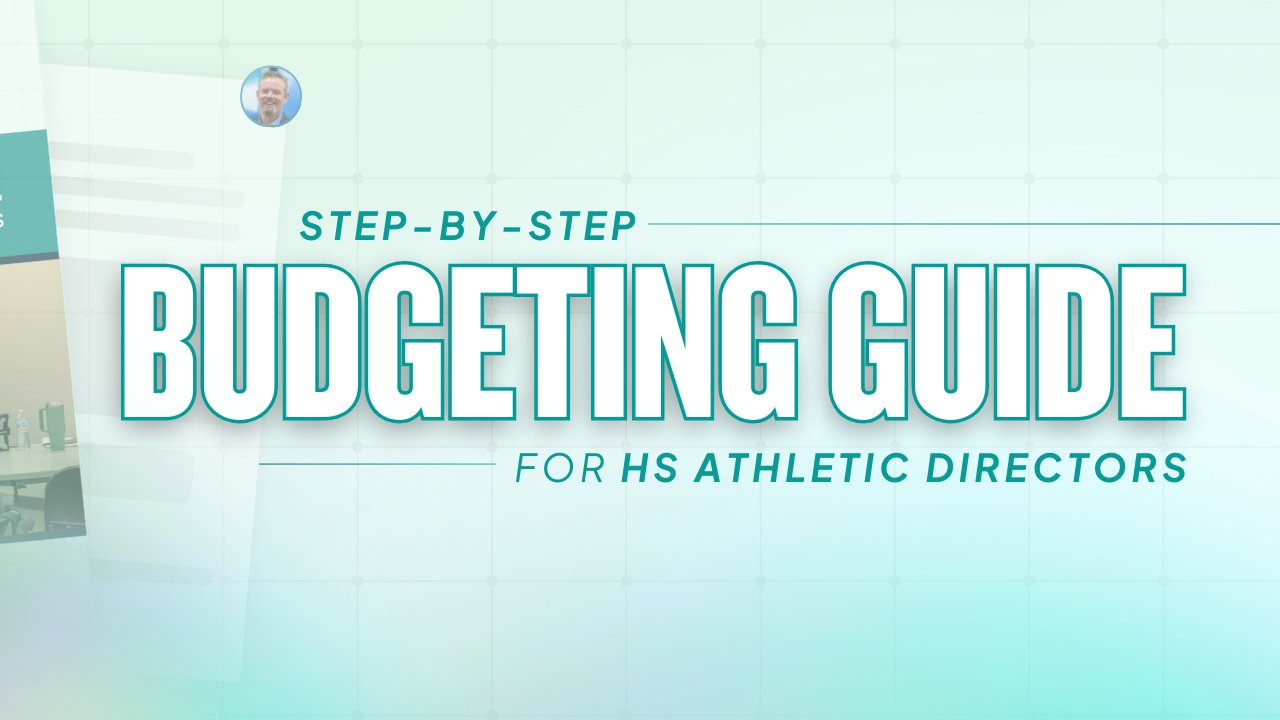From managing schedules and staff to building school culture and setting a vision, the responsibilities of an athletic director go far beyond game day. In this guide, we share 10 practical ways to become a more effective, respected, and impactful athletic director. Whether you're new to the role or a seasoned vet, these strategies will help you lead your program with confidence and clarity.
1. Master Time Management
2. Embrace Technological Advancements
3. Cultivate Exceptional Communication Skills
4. Develop a Strategic Vision for Your Athletic Department
5. Foster Strong Relationships with Coaches and Staff
6. Engage Actively with the School and Community
7. Implement Effective Event Management Practices
8. Prioritize Student-Athlete Development and Welfare
9. Maintain Financial Acumen and Resource Management
10. Commit to Continuous Professional Development
1. Master Time Management
The dynamic nature of athletic programs requires ADs to juggle multiple responsibilities simultaneously. Implementing time-blocking techniques, setting clear priorities, and delegating tasks when appropriate can enhance efficiency. Utilizing digital tools for scheduling and task management can also streamline operations, ensuring that critical duties receive the attention they deserve.
Here are specific recommendations to help you master time management and set clear priorities:
Use a Calendar Blocking System
Set aside specific times of day for your recurring tasks — such as answering emails, reviewing reports, or meeting with coaches. Tools like Google Calendar allow you to visually block your time so you can stay focused and avoid task-switching. Label blocks like:
-
8:00–9:00 AM: Staff check-ins and urgent emails
-
10:00–11:00 AM: Scheduling and logistics
-
2:00–3:00 PM: Facilities and event prep
-
4:00–5:00 PM: Follow-up calls and reports
Make a Daily Priority List
Begin each day by identifying the top three tasks that must be accomplished. Use the Eisenhower Matrix to separate urgent vs. important items and delegate or defer where appropriate:
-
Do Now: Crisis management, event cancellations
-
Schedule: Budget planning, staff evaluations
-
Delegate: Field prep, minor communications
-
Eliminate: Low-impact tasks that don't serve your goals
Tools like Todoist, Trello, or even a whiteboard in your office can help manage your lists and keep priorities visible.
Implement a 15-Minute Rule
When you're short on time or energy, tackle difficult tasks by committing just 15 focused minutes. This prevents procrastination and often creates momentum to finish the job.
Build in Buffer Time
Add 15–30 minutes between meetings and major tasks. This allows you to catch your breath, deal with unexpected issues (which are guaranteed to pop up), and avoid a cascading effect of delays.
Limit Distractions
Turn off non-essential notifications, close unused browser tabs (we're all guilty of this), and set specific times to check email. Use focus tools like:
-
“Do Not Disturb” mode on your phone/computer
-
Noise-canceling headphones for focused work blocks
Conduct Weekly Reviews
At the end of each week, spend 20–30 minutes reviewing what worked, what didn’t, and what needs to shift. Ask yourself:
-
Did I spend too much time on low-impact tasks?
-
What could I delegate next week?
-
What recurring fires can I prevent with better planning?
Delegate Like a Leader
You’re not meant to do everything alone. Empower your coaching staff or trusted student assistants to handle routine tasks like field or equipment setup.
2. Embrace Technological Advancements
In today's fast-paced and data-driven environment, embracing technology isn't just a convenience—it's a necessity for effective athletic program management. The best Athletic Directors leverage modern tools to automate routine tasks, enhance communication, and provide stakeholders with real-time information. Here’s how to make the most of tech in your role:
Here are specific recommendations to help you embrace technological advancements:
Adopt All-in-One Management Platforms
Invest in a comprehensive system like Bound that integrates scheduling, rosters, eligibility, facilities, team communication, ticketing, financial reporting, and more. These platforms eliminate the need for juggling multiple apps and spreadsheets and instead centralize all athletic operations. This saves time, reduces errors, and ensures consistent communication with coaches, parents, and students.
Go Mobile and Meet Stakeholders Where They Are
Encourage your school community to use a mobile app tied to your management platform. A well-designed app allows parents to receive instant updates, purchase tickets, follow their child's team, and more—all from their phone. When your community is engaged digitally, you’ll spend less time fielding calls and emails for basic info.
Use Data to Inform Decisions
Technology gives you access to valuable insights—from attendance trends at games to the performance of various teams. Use this data to guide resource allocation, facility use, coaching evaluations, and event planning. Over time, you’ll spot patterns that help you lead with intention rather than react to problems.
Streamline Communication
Adopt tools that allow you to easily message segmented audiences (like only coaches, or only parents of fall athletes). With a robust communication system, you can send last-minute schedule changes, weather alerts, or reminders with just a few clicks.
Keep It Secure and Compliant
Use technology that helps you stay FERPA and HIPAA compliant, especially when dealing with student data and medical forms. Choose platforms that offer role-based access, audit trails, and secure document management.
Stay Informed on What’s Next
Set aside time to learn about new tools, trends, and platforms entering the athletic space. Attend tech-focused workshops at conferences, subscribe to industry newsletters, and network with other tech-forward ADs. Being open to innovation helps your program remain modern and competitive.
3. Cultivate Exceptional Communication Skills
Effective communication is the cornerstone of successful athletic administration. ADs must articulate expectations clearly to coaches, athletes, parents, and the broader school community. Regular meetings, detailed newsletters, and open-door policies can foster transparency and trust. By ensuring that all stakeholders are informed and heard, ADs can preempt misunderstandings and build a cohesive athletic environment.
Here are specific recommendations to help you cultivate exceptional communication skills:
Hold Regular Stakeholder Meetings
Schedule consistent check-ins with coaching staff, student-athletes, and booster clubs. Even an informal weekly, bi-weekly, or monthly coaches' meeting keeps everyone aligned and allows for proactive problem-solving.
Use a Unified Communication Platform
Investing in one singular communication tool for your entire program allows you to centralize messaging across teams and seasons. This reduces miscommunication and keeps everyone on the same page.
Create a Monthly AD Newsletter
Use this to share updates, policy reminders, student-athlete spotlights, and upcoming event info. Keep it short, visual, and easy to skim—this becomes a touchpoint that keeps your program top-of-mind.
Develop a Clear Chain of Communication
Ensure that everyone understands who to contact and when. For example, student-athletes should report concerns to coaches before escalating them to the AD. Communicating this protocol prevents confusion and builds efficiency.
Practice Active Listening
When issues arise, listen with empathy and without interrupting. Reflect back what you hear to ensure clarity. Active listening builds trust and helps resolve conflicts with integrity.
Use Video for Important Messages
Record short video messages for key announcements like playoff details, new policies, or celebrations. It’s more engaging than email and helps put a face and voice to leadership.
Maintain an Open-Door Policy
Let your coaches and athletes know they can reach out directly. Being approachable builds rapport and helps catch small issues before they become big problems.
4. Develop a Strategic Vision for Your Athletic Program
A clear, strategic vision provides direction and purpose. ADs should collaborate with stakeholders to establish goals that align with the school's mission, emphasizing both athletic excellence and personal development. Regularly revisiting and reflecting on this vision ensures that the athletic program evolves to meet changing needs and challenges.
Here are specific recommendations to help you develop a strategic vision for your athletic program:
Start With Core Values
Identify the foundational principles of your athletic department. These could include sportsmanship, academic achievement, inclusivity, character development, or community engagement. Use these values to shape your vision and all major decisions.
Create a Vision Statement
Write a clear, concise vision statement that captures what you want your program to become. Example: “To build a culture of excellence where student-athletes grow as leaders, succeed in the classroom, and compete with integrity.”
Set Short- and Long-Term Goals:
Develop annual goals as well as long-term benchmarks (3–5 years). Goals could include:
- Increasing participation rates to X amount.
- Improving X-Y-and Z facilities.
- Launching a leadership development program for student-athletes.
- Enhancing community involvement.
Collaborate With Stakeholders
Get input from coaches, parents, students, and administrators. Use surveys, small-group discussions, or a strategic planning committee to ensure the vision reflects shared priorities.
Develop an Action Plan
Once goals are set, map out how you’ll reach them. Assign responsibilities, set timelines, and identify resources needed. For example, if a goal is to increase community sponsorship, your plan might include forming a fundraising committee and developing marketing materials.
Regularly Revisit and Reflect
Your strategic vision isn’t static. Schedule annual reviews to measure progress, celebrate wins, and adjust for new challenges. Make these updates visible and communicate progress to your community.
Communicate Often and Everywhere
Your vision should show up in everything from preseason parent meetings to hallway posters to school board presentations. Repetition reinforces direction and builds buy-in.
5. Foster Strong Relationships with Coaches and Staff
Building and maintaining positive relationships with coaches and staff members is essential. Regular check-ins, professional development opportunities, and recognition of achievements can boost morale and performance. By creating an environment of mutual respect and support, ADs can cultivate a dedicated and effective team.
Here are specific recommendations to help you foster strong relationships with coaches and staff:
Hold Regular One-on-Ones
Schedule monthly or bi-monthly check-ins with each head coach. Use these meetings to discuss team needs, upcoming events, and any issues they may be facing. These check-ins show that you value their perspective and are invested in their success.
Facilitate Peer Learning and Collaboration
Create opportunities for coaches to learn from one another. Host roundtable discussions, invite guest speakers, or run peer-led professional development sessions. Shared experiences promote unity and improve coaching quality.
Recognize and Celebrate Efforts
Publicly acknowledge coaches who go above and beyond—whether it’s managing a tough season, mentoring an athlete, or organizing a successful fundraiser. A quick shout-out at a staff meeting or a written note can go a long way.
Provide Clear Expectations and Resources
Be transparent about what you expect from your coaches in terms of communication, team conduct, and administrative responsibilities. Just as important—make sure they have the tools and support to meet those expectations.
Involve Coaches in Program Planning
Give your coaching staff a voice in shaping the future of your athletic programs. Involve them in discussions about scheduling, facility upgrades, and long-term goals. Their input will improve decisions and increase buy-in.
Encourage Healthy Work-Life Balance
Coaches face burnout just like administrators. Encourage boundaries and wellness by modeling balance in your own leadership and supporting time off when possible.
6. Engage Actively with the School and Community
Community engagement isn't just a bonus—it’s a vital piece of an athletic director's leadership role. A well-connected athletic program thrives when the school and community feel like stakeholders in its success.
Here are specific recommendations to help you engage actively with your school and local community:
Attend Events Beyond Athletics
Make an effort to attend fine arts performances, academic ceremonies, youth events, and other non-athletic events. This shows you're invested in the whole student body and strengthens collaboration with faculty and administration.
Create a “Community Champion” Program
Recognize local businesses and individuals who support your program—through sponsorships, volunteering, or attendance—at halftime or on social media. Gratitude goes a long way in building loyalty.
Establish a Parent Advisory Group
Host quarterly meetings with a mix of parents from different sports and levels. Use these meetings to gather feedback, promote transparency, and share updates.
Partner with Local Youth Sports Programs
Offer youth nights at varsity games, clinic invitations, or mentorship opportunities between high school athletes and younger kids. This creates a feeder system and enhances long-term support.
Collaborate with Local Media
Build relationships with local newspapers, radio, and online outlets to increase visibility for your athletes and events. Regular press releases, athlete spotlights, and game recaps are helpful.
Use Digital Tools to Engage
Maintain an active presence on social media and your school’s athletic website. Post updates, celebrate achievements, and share behind-the-scenes content to make your program more personal and engaging.
Host Community Nights and Theme Games
Organize events like Military Appreciation Night, Youth Sports Night, or Teacher Appreciation Night. These increase attendance, generate school spirit, and deepen community involvement.
Foster Alumni Relations
Create an alumni network through email newsletters or dedicated social channels. Invite alumni to games, honor them at events, and include them in fundraising efforts.
7. Implement Effective Event Management Practices
Athletic events are the front porch of your school’s sports program, and their success reflects directly on the athletic department. As an AD, your ability to manage these events efficiently can enhance your program’s credibility and community support—while reducing stress and last-minute chaos.
Here are specific recommendations to help you master event management:
Create Event Playbooks
For each sport and event type (homecoming, senior night, tournaments), build a playbook that outlines timelines, key contacts, logistics, and responsibilities. This helps ensure consistency across seasons and years, especially helpful if staff changes.
Use a Digital Scheduling Tool
Embrace software that consolidates schedules, transportation, officials assignments, and facility management. Look for tools that sync with your website and allow real-time updates for weather or time changes. Bound’s platform, for example, allows this integration all in one place.
Assign Roles & Delegate Clearly
Don’t shoulder every responsibility. Assign roles for gate workers, clock operators, announcers, concessions, ticketing, and security. Share expectations in advance and follow up with reminders a few days before events.
Establish Communication Channels
Use a consistent method (text groups, apps, or emails) to communicate with coaches, custodial staff, transportation, and volunteers before and during events. Ensure everyone knows who to contact if an issue arises.
Develop Pre-Event and Post-Event Checklists
Make a checklist to prepare each venue—think banners, water coolers, signage, crowd control—and another for post-event wrap-up like equipment breakdown, reporting scores, and sending thank-yous.
Gather Feedback for Continuous Improvement
After big events, debrief with coaches, volunteers, and staff. What went well? What could improve? Use feedback to improve future events and make everyone feel heard and appreciated.
Plan for the Unexpected
Have backup plans in place for inclement weather, absent workers, and medical emergencies. Share contingency plans with staff and ensure all event workers know emergency protocols.
8. Prioritize Student-Athlete Welfare and Safety
Ensuring the physical and emotional well-being of student-athletes is paramount. ADs must enforce safety protocols, provide access to medical resources, and promote a culture of respect and inclusivity. Regular training sessions on topics like concussion awareness and mental health can further safeguard student-athletes.
Here are specific recommendations to help you prioritize student-athlete welfare and safety:
Enforce Rigorous Safety Protocols
-
Implement and routinely update emergency action plans (EAPs) for every facility and event.
-
Conduct pre-season safety meetings with coaches to review protocols for heat illness, cardiac arrest, concussions, and more.
-
Require annual safety certifications for all coaches (CPR, First Aid, Concussion Protocols).
Promote Access to Medical Resources
-
Ensure certified athletic trainers (ATCs) are available at high-contact and high-risk events.
-
Maintain up-to-date medical equipment at all venues—AEDs, first-aid kits—and train staff on their usage.
-
Build relationships with local hospitals and physicians for faster referrals and evaluations.
Support Mental Health and Emotional Resilience
-
Incorporate mental health education into your athletic programming by hosting guest speakers or workshops.
-
Normalize conversations about stress, anxiety, and mental fatigue. Create safe spaces for student-athletes to seek support.
-
Encourage coaches to build relationships with athletes that extend beyond performance—emphasize empathy, understanding, and open communication.
Create a Culture of Inclusivity and Respect
-
Make it clear that your program stands for equity, inclusion, and zero tolerance for bullying or discrimination.
-
Encourage student leadership programs that reinforce team accountability, character, and a culture of belonging.
Monitor Workload and Burnout
-
Work with coaches to prevent overtraining and monitor athlete burnout, especially for multi-sport or year-round participants.
-
Prioritize recovery and rest in scheduling practices and games—burnout leads to both physical injury and mental fatigue.
Establish Clear Communication Channels
-
Use tools like team communication apps or portals to share updates, medical alerts, or safety reminders.
-
Ensure parents and guardians are kept in the loop, especially when medical issues arise. Transparency builds trust.
9. Maintain Financial Acumen and Resource Management
Effective budgeting and resource allocation are critical for sustaining athletic programs. ADs should monitor expenditures, seek funding opportunities, and ensure equitable distribution of resources among sports. Transparent financial practices build trust and ensure the longevity of athletic initiatives.
Here are specific recommendations to help you maintain financial acumen and resource management:
Build a Detailed, Yearly Budget
Start each school year with a clearly defined budget for each sport, taking into account equipment needs, travel, officials, facility rentals, and coaching stipends. Create individual line items per team and review spending history from the previous 1–3 years to set realistic projections. Include a buffer for unexpected costs, and meet with coaches to confirm their needs and set expectations.
Track Expenses and Revenue Monthly
Use a system or platform that helps you reconcile athletic department revenue and expenses monthly. Categorize income by source (e.g., ticket sales, booster donations, fundraising, sponsorships) and make sure all expenses are logged and verified with receipts or invoices. Platforms like Bound allow for integrated financial tracking tied to events, concessions, ticketing, and store sales—making your reporting much easier and more transparent.
Report Transparently
Make a habit of producing quarterly or semester-based reports to share with your school’s administration, school board, or booster clubs. Include summaries of expenses vs. income, comparisons to budget goals, and a short narrative about how funds are supporting students. This increases transparency and promotes continued support.
Maximize Funding Opportunities
Actively pursue grants, sponsorships, and partnerships with local businesses. Create sponsorship tiers that offer value back to your community (e.g., Bound app and school website ads, digital scoreboard ads, banners at events, mentions on livestreams). Collaborate with your booster club to host organized and strategic fundraisers—not just selling cookie dough but offering value-based events like golf tournaments, fan gear pop-ups, or alumni nights.
Ensure Equitable Resource Distribution
Equity in athletics doesn’t mean every sport gets the same funding—but it does mean that each program receives the support it needs to provide a high-quality experience. Use data from participation numbers, competitive needs, and safety requirements to ensure fair distribution. Be transparent with coaches about how and why funds are allocated.
Audit and Adjust
Set aside time each season to audit your finances. Are there recurring expenses that can be reduced? Are you overspending in one category and underspending in another? Use this insight to adjust next year’s budget and improve your long-term financial planning.
10. Commit to Continuous Professional Development
The landscape of athletic administration is ever-evolving. ADs should pursue ongoing education through workshops, certifications, and professional networks (like LEAD). Engaging with peers and staying informed about industry trends fosters innovation and adaptability, essential traits for long-term success.
Here are specific recommendations to help you commit to continuous professional development:
Earn Certifications and Designations
Pursue certifications through the National Interscholastic Athletic Administrators Association (NIAAA) such as:
-
Registered Athletic Administrator (RAA)
-
Certified Athletic Administrator (CAA)
-
Certified Master Athletic Administrator (CMAA)
These credentials not only improve your competency but also increase your credibility within your school and professional networks.
Attend Conferences and Clinics
Make it a goal to attend at least one regional or national conference each year, such as the National Athletic Directors Conference or your state’s athletic administrator association gathering. These events offer valuable learning sessions, networking opportunities, and exposure to new products and solutions in the industry.
Join Professional Networks
Stay engaged with online forums and groups that are rich with real-time problem-solving discussions, document sharing, and peer support. You’ll learn what’s working for other ADs and gain new perspectives.
Create a Personal Growth Plan
At the beginning of each school year, identify 2–3 areas you want to grow in (e.g., digital ticketing, equity in athletics, fundraising strategies). Set goals and timelines to develop these skills through courses, books, mentorship, or hands-on projects. Share your goals with a mentor or supervisor to stay accountable.
Read Books and Blogs from Industry Experts
Read at least one professional development book each semester. Great options include:
-
The DNA of an AD by Scott Garvis, CMAA
-
3D Coach by Jeff Duke
-
Lead...for God’s Sake! by Todd Gongwer
-
Also, subscribe to blogs and newsletters like those from Bound, Coach & AD, or others for fresh insights and leadership strategies.
Build a Mentorship Circle
Connect with veteran ADs who’ve walked the path before you. Likewise, offer support and share your experiences with new ADs. This two-way mentorship is invaluable for perspective, encouragement, and inspiration.
Reflect and Recalibrate
Build in time at the end of each season to reflect: What did you learn? What challenges exposed growth opportunities? Use these reflections to shape your professional development for the next year.
By integrating these strategies into your daily practices, you can create positive change at your school and leave a lasting impact on the student-athletes you serve.
About Bound
Bound is an all-in-one Athletics Management System (AMS) designed specifically to help high school athletic administrators lead more and manage less. The platform is developed by former athletic administrators and coaches to streamline processes like scheduling, ticketing, registration, facility management, communication, and 15+ other tasks in one place. Trusted nationwide, Bound helps athletic administrators simplify operations, save time, and efficiently manage their day-to-day.





